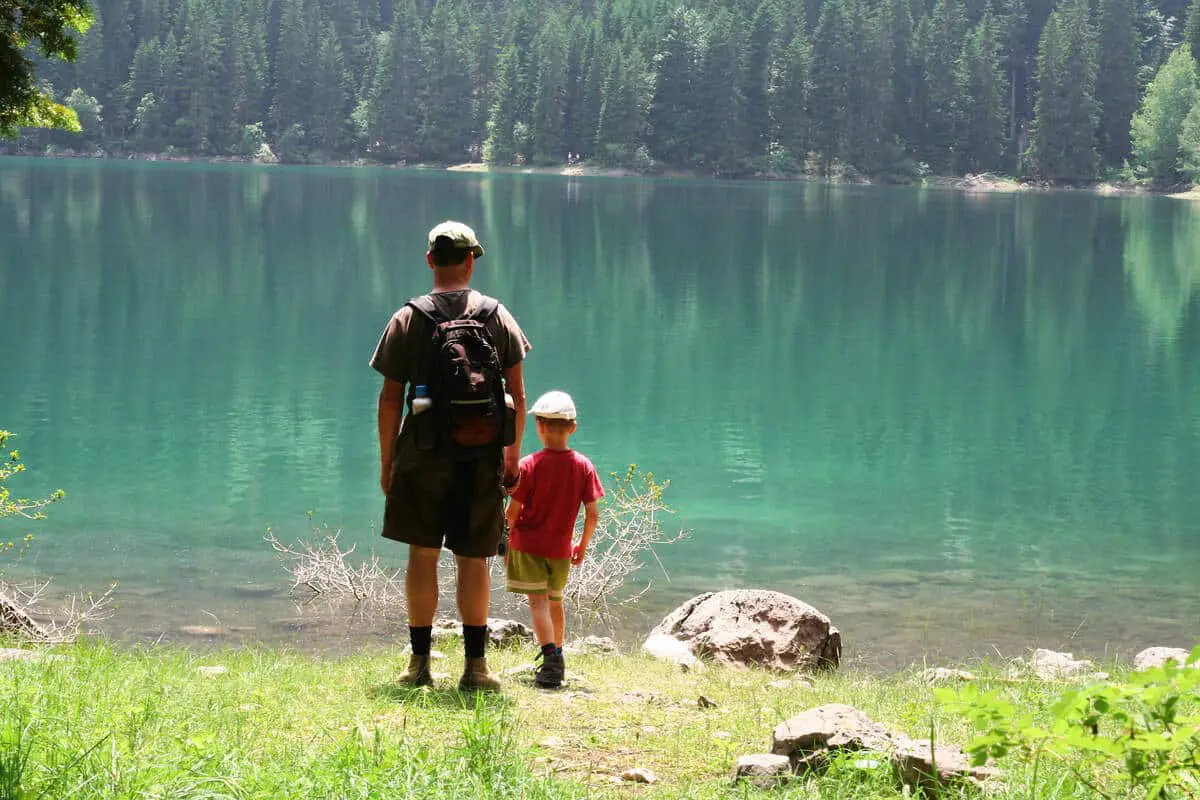Thinking about hiking in Banff National Park with your kids, but worried about safety? Well, not anymore, because I have laid out some valuable tips and guidelines in this article. They’ll help you have a wonderful and safe time hiking in the Canadian Rockies with your little ones.
I get it, the Rocky Mountains. With their inclement weather, steep cliffs, and bears. Sounds anything but safe. But you know what? If you prepare well, you and your family should be fine.
That’s good news, because hiking in Banff is totally worth it! You’ll create positive outdoor experiences for your kids, hopefully instill a love of the outdoors, enjoy quality time together, and snap ome amazing pictures, all at the same time.
Sound good? Alrighty.
Well, let’s take a look at what it takes to prepare for a Banff hike with your child.
Planning Your Hike with Kids in Banff
When planning a hike with your kids in Banff, you want to consider several factors to ensure a safe and enjoyable adventure.
For example, knowing the difficulty level of a trail. Hiking trails in Banff are rated as easy, moderate, difficult and challenging. You’ll have a more relaxed and enjoyable time with your kids by choosing an age-appropriate route, such as the easy Banff hikes.
Before hitting the trails, make sure you and your family have the proper gear. Also, stay on designated trails and carry essentials such as water, snacks and maps.
Once you’ve chosen a trail to hike, you should do two more things before you head out: consider the distance and duration of your hike, and check the weather conditions.
Choosing an Appropriate Trail
Finding the right trail for your family is critical to a successful hike. Consider your children’s ages, abilities and interests when choosing a trail. Banff offers several kid-friendly hikes, such as the Johnston Canyon hike, which features safe, elevated boardwalks and a manageable distance of about 5.0 kilometers or 3.11 mi (see below for a description).
The Stewart Canyon Trail near Lake Minnewanka is an easy hike with beautiful scenery. Look for trails that are well-maintained, have clear signage, and offer cool features like waterfalls or wildlife viewing opportunities.
Checking Weather Conditions
This may seem obvious, but I’ll mention it anyway: Always check the weather forecast before you go hiking. You’re in the Canadian Rockies, after all, and the weather can easily make otherwise non-hazardous situations dangerous.
Rain, snow or high winds can be challenging if you and your family are inexperienced hikers. And your kids probably are. So dress in layers and bring clothing appropriate for the conditions you expect.
Even if the forecast is clear, packaging extra clothing and rain gear is also a good idea. Mountain weather can be unpredictable, and you want to be prepared for sudden changes.
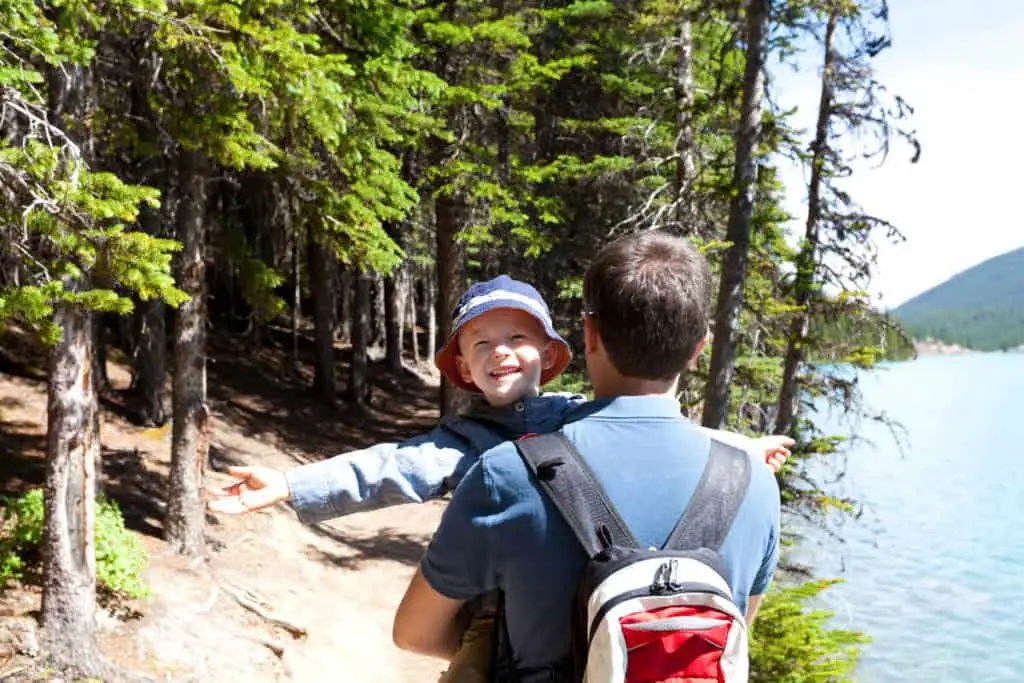
Timing and Pacing
Start your hike early in the day and allow plenty of time for rest stops, snack breaks, and pauses to enjoy the sights. Set a pace that is comfortable for your kids, and avoid pushing them too hard.
Also: Be prepared to adjust your hike’s length or difficulty if your kids become tired or lose interest.
Safety Measures for Hiking with Kids in Banff
When hiking with children in Banff, it’d be smart to take certain safety precautions to keep you and your family safe. This means you’ll have less to worry about and more to enjoy!
Gear and Equipment
The right gear and equipment are crucial for a safe and comfortable hike. Here are the items you shouldn’t forget:
Footwear: Get good-quality hiking boots to ensure proper trail support and grip. Your kids should wear footwear that fits them well and is suited for the terrain.
Clothing: Dress in layers and carry extra clothing in case the weather changes. Opt for waterproof and breathable clothing if possible, to stay comfortable in varying conditions.
Backpack: If your kid is wearing a backpack it should have a fitting backpack with padded shoulder straps and a hip belt to distribute weight evenly. Make sure your bag is not too heavy for them.
Cap: Have your kids wear a cap on scorching days to prevent them from sunstroke or dizziness.
Sunscreen: Bring a good quality sunscreen with a high protection factor to prevent sunburn. Even though you’re in the mountains, the sun can be intense.
Navigation Skills
Equipping yourself with basic navigation skills is essential for staying on track and navigating Banff’s trails. Here’s what you’ll need to do just that:
Map and compass: It is always wise to carry a physical map and compass, even if you rely on electronic devices such as smartphones or GPS. Teach your kids how to read a map and use a compass. If you don’t really need it during your Banff hike, it might come in handy some other time.
This doesn’t mean you shouldn’t take your phone with you. If fully charged, using an app like AllTrails should last a while. Just take a powerbank with you in case your phone battery dies so you can recharge it.
Don’t count on a mobile signal. In most areas of the park, coverage is at least spotty and probably non-existent. This makes it even more important to be prepared, as you may not be able to call for help in an emergency.
Trail markers: Keep an eye on trail markers and signs to stay on the right path. Teach your children to recognize these markers and point them out as you hike.
Knowing when to turn back: If you realize you’ve ventured off the designated trail or the weather takes a turn for the worse, turn back and seek help if needed.
Wildlife Awareness
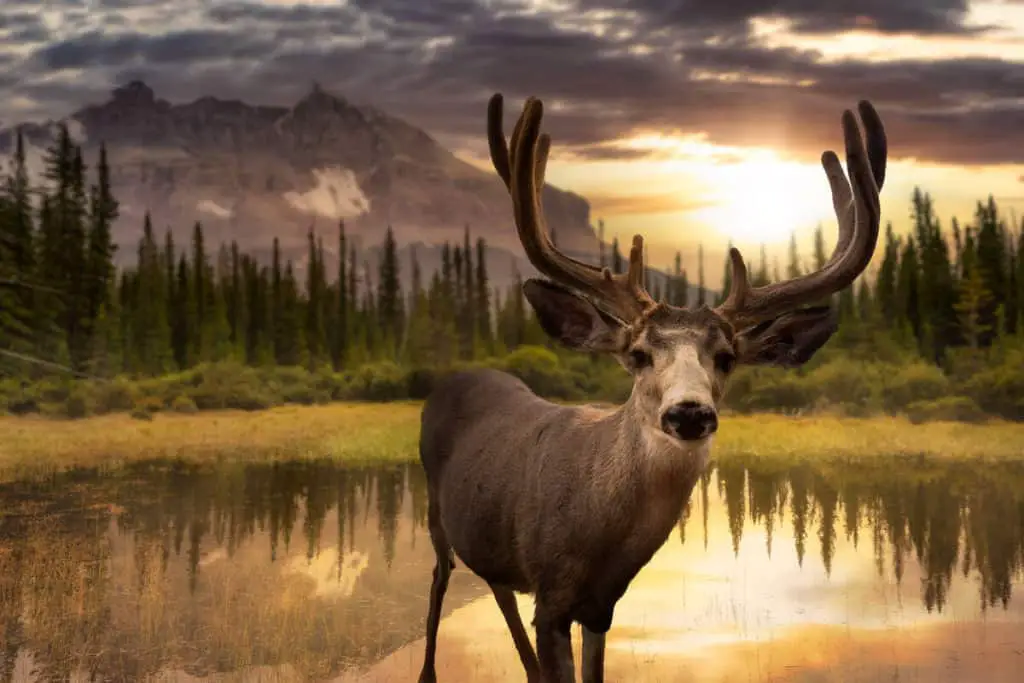
Being aware of Banff’s wildlife is paramount to your safety. Follow these tips to ensure a safe and respectful encounter with the park’s wildlife:
Maintain distance: Keep yourself and your kids at a safe distance from wildlife. Avoid approaching or feeding the animals, and encourage your children to observe quietly and respect the animals’ space.
Stay in groups: Hiking in groups reduces the chances of unexpected encounters with wildlife. Larger groups are more likely to be noticed by animals, giving them time to move away.
Carry bear spray: If you’re hiking in bear country, carry bear spray as a preventive measure. Educate yourself and your kids on its proper use before setting out on the hike.
If you wanna know more about bear spray, I have a whole article dedicated to bear spray in Banff, including where to get it and where to dispose of it.
Snacks and Hydration while Hiking with Kids in Banff
Packing Nutritious Snacks
When planning a hike with your kids in Banff, it’s important to pack nutritious snacks that will keep everyone energized and satisfied throughout the day. Packaging a mix of carbohydrates, protein, and healthy fats is an excellent way to maintain steady energy.
Some great snack choices include:
Trail mix: This classic hiking snack is perfect for its portability and variety. Mix nuts, seeds, dried fruits, and even some chocolate for a tasty, energy-packed treat.
Granola bars: Choose granola bars with whole grains, nuts, and dried fruits for a balanced and filling snack option.
Fruit: Apples, bananas, and oranges are convenient choices that don’t require packaging and can handle being carried in a backpack.
Jerky: Beef, turkey, or other types of jerky provide a good source of protein to keep hunger at bay.
But by all means, feel free to get creative with your snack choices and consider your kids’ preferences.
Staying Hydrated
Staying hydrated is just as important as fueling up with nutritious snacks during your hike. Dehydration can lead to fatigue, dizziness, and more serious health problems if not treated immediately. Here are some tips to help you and your kids stay hydrated:
Pack enough water: It’s recommended that each person carries at least 1 liter of water for every 2 hours of hiking. For a family, that means bringing a sizeable water supply in reusable bottles or hydration packs.
Sip frequently: Encourage your kids to take small sips of water throughout the hike, even if they don’t feel thirsty. Regular sips will help prevent dehydration and keep everyone feeling their best on the trail.
Avoid caffeine; alcohol: Yup, these drinks can contribute to dehydration, so avoid them during your hike. Instead, stick to water, or consider electrolyte replenishing drinks for longer hikes.
Focusing on proper nutrition and hydration will set your family up for a safe and enjoyable hike in Banff National Park. Now ain’t that reassuring?!
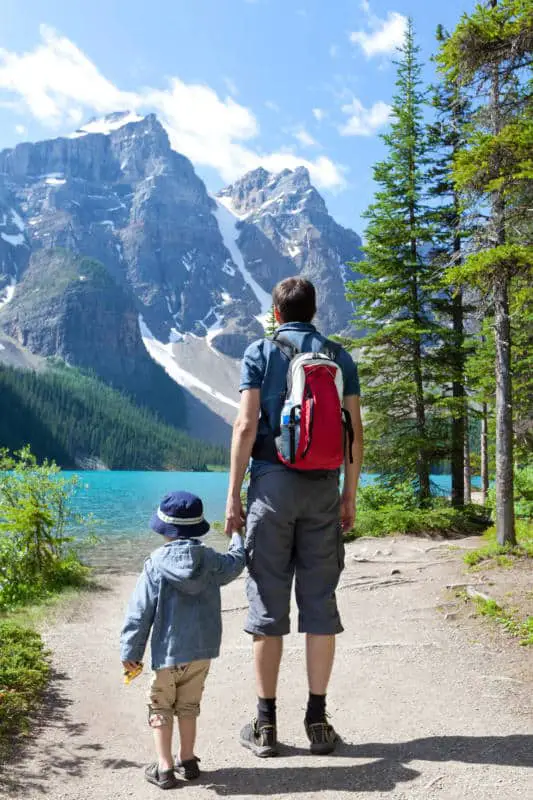
Keeping Kids Engaged while Hiking in Banff
Fun Activities Along the Trail
While hiking in Banff with your kids, engaging them in fun activities can make the experience memorable and enjoyable. To do this you could introduce wildlife spotting games by teaching them how to identify different animals and their tracks. For instance, you could do a scavenger hunt to help them learn about their surroundings while keeping them motivated.
If your kids are very young, incorporating creative storytelling about the landscape or animals they see can keep their imaginations engaged as they appreciate the natural beauty around them. Meanwhile, older kids may enjoy nature photography challenges so they can capture their own memories of their adventure!
Teaching Outdoor Etiquette
While this has nothing to do with safety when hiking with kids in Banff, I thought it would be good to throw it in here: outdoor etiquette. After all, why not teach your kids the importance of responsible hiking and outdoor behavior while you’re at it, right?
You could start by introducing the principles of Leave No Trace, which encourages hikers to minimize their environmental impact. Explain why respecting plants, animals, and other hikers is important by staying on designated trails and keeping noise levels low.
You can also involve your children in practicing proper trail etiquette, such as yielding to other hikers and ensuring everyone stays on the right side of the trail. Finally, be sure to pick up after yourself and your children and leave Banff National Park as beautiful as you found it. It’s only common sense, isn’t it?
What Hikes in Banff National Park Are Suited for Kids?
To make it easy for you, I have selected nine kid-friendly trails near the towns of Banff and Lake Louise. In the table below you’ll find some important information. I also included a brief description of each trail.
Happy family hiking!
| Hike Name | Distance | Duration | Difficulty | Trailhead |
|---|---|---|---|---|
| Johnston Canyon | 5.8 km (3.6 mi) | 1.5-2 hours | Moderate | Johnston Canyon Parking Lot |
| Tunnel Mountain Trail | 4.3 km (2.7 mi) | 1.5-2.5 hours | Easy | Tunnel Mountain Drive |
| Bow River Loop | 2.1 km (1.3 mi) | 0.5-1 hour | Easy | Bow Falls Parking Lot |
| Two Jack Lake Trail | 3.2 km (2.0 mi) | 1-1.5 hours | Easy | Two Jack Day-Use Area |
| Sundance Canyon Trail | 9.0 km (5.6 mi) | 2.5-3.5 hours | Easy | Cave and Basin National Historic Site |
| Lake Louise Lakeshore | 4 km (2.5 mi) | 1-2 hours | Easy | Lake Louise Parking Lot |
| Moraine Lake Lakeshore | 3.4 km (2.2 mi) | 0.5-1 hour | Easy | Moraine Lake Parking Lot |
| Marsh Loop Trail | 3.4 km (2.2 mi) | 1-1.5 hours | Easy | Cave and Basin National Historic Site |
| Fenland Trail | 1.8km (1.1 mi) | 0.5-1 hour | Easy | Off Mount Norquay Road near the town of Banff |
- Johnston Canyon: This popular hike offers a captivating experience as you walk along catwalks and bridges, passing beautiful waterfalls and through a narrow canyon. The trail is well-maintained. Restrooms are available at the trailhead, but there are no picnic tables along the trail.
- Tunnel Mountain: Despite its name, this hike is family friendly and offers breathtaking views of downtown Banff, Mount Rundle, the Bow River and the Bow Valley. The trail starts near the Banff Centre on Tunnel Mountain and gradually climbs to the summit. There are no facilities om this trail unfortunately, also no restrooms. So I recommend you let your kids use the toilet before you head out.
- Bow River Loop: This easy loop offers scenic views of the Bow River and Bow Falls. It’s a great option for a leisurely walk with young kiddos. You’ll have opportunities to spot wildlife and enjoy the river scenery. While you’d expect to find restrooms here, as the Bow Falls are very touristy, there are no restrooms directly on the trail.
- Two Jack Lake Trail: Located near the Two Jack Lake campground in Banff National Park, the Two Jack Lake trail is a scenic and family-friendly hike. The trail follows the shoreline of Two Jack Lake allowing for beautiful views of the lake and the surrounding mountains. Restrooms are available at the Two Jack Lake campground.
- Sundance Canyon: Located near the Cave and Basin National Historic Site, this hike takes you through a picturesque canyon. The trail is relatively flat and the first few kilometers take you over a paved path. Restrooms are available at the Cave and Basin site, but there are no picnic tables along the trail.
- Lake Louise Lakeshore: This scenic hike follows the shoreline of Lake Louise, so you’ll have stunning views of the turquoise lake and the surrounding mountains. The trail is relatively flat and therefore perfectly suitable for families. Restrooms are available at the Lake Louise Parking Lot, but there are no picnic tables. After the hike you could have lunch or diner in the Château Lake Louise.
- Moraine Lake Lakeshore: This short and easy hike offers incredible views of the iconic Moraine Lake and the surrounding Valley of the Ten Peaks. The trail follows the lakeshore, with way too many photo opportunities. Restrooms are available near the Moraine Lake Parking Lot, but there are no picnic tables along the trail.
- Marsh Loop: Located near the Town of Banff, the Marsh Loop offers a pleasant stroll through wetlands and marshes. It’s an easy trail, making it suitable for families. You’ll have opportunities to spot birds and other wildlife. Unfortunately, there are no restrooms available at the trailhead, and there are no picnic tables along the trail.
- Fenland Trail: Also near the town of Banff, the Fenland Trail is a peaceful loop that takes you through a forested area along the Bow River. It’s an easy hike that offers a chance to enjoy nature without getting too far out of town. In fact, you could easily walk here from the Banff Avenue shopping district. It’s that close. There are no restrooms at the trailhead. The same goes for picnic tables along the trail.
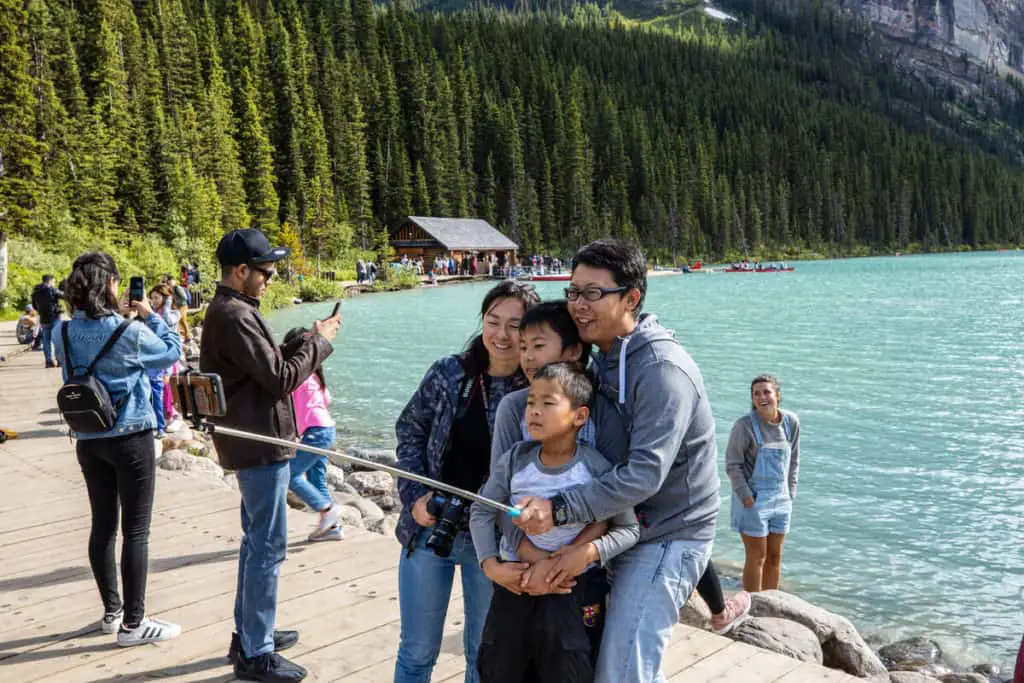
Banff Travel Guide and FAQ
Where is Banff National Park, Canada?
Banff National Park is in the southwest of the province of Alberta. It’s home to the towns of Banff and Lake Louise and borders the province of British Columbia in the west of Canada. You can easily access famous places like Lake Louise, Moraine Lake, Peyto Lake and the stunning Icefields Parkway from these locations.
Banff and Lake Louise are situated in the Rocky Mountains of Alberta, close to the boundary with British Columbia, as shown on the map of Banff National Park below.
Is Banff, Canada safe?
Generally speaking, yes. Like most areas, Banff has crime, but it’s still a safe travel place. But Banff has a lot of wildlife, including bears and cougars, so you should always carry bear spray and exercise caution when hiking in the mountains.
What is the best time to Travel to Banff, Canada?
The best time to travel to Banff, Canada, depends on your reason for visiting the park. If you’re going for the stunning nature the park’s famous for, you’d better visit from June to September. The best months to ski are from January through March.
WEATHER IN BANFF, CANADA: AVERAGE TEMPERATURE

The worst months to visit Banff National Park are November, April and May. It’s too chilly to go sightseeing in November, and there isn’t enough snow on the slopes yet. The iconic lakes in the park are still frozen in April and May, and it can still be quite cold.
How do I travel to Banff, Canada?
Want to fly to Banff? Calgary International Airport (Code: YYC) is the closest airport. It’s 130 kilometers (81 mi) to the east of Banff.
Several cities, including Toronto, Chicago, Seattle, and Dallas/Fort Worth, have direct flights into Calgary.
Pick up a rental vehicle at Calgary International Airport, or take a private transport service to your destination. The trip to the park takes about 1 hour and 40 minutes.
Viator has several good options. Click the link to check the options and latest rates.
Banff Car Rental
Want to rent a car during your stay in Banff National Park? Rent one at Calgary International Airport or in the city of Calgary. Yep, there are rental firms in Lake Louise and Banff, but as these are small towns, your rental options can be limited.
Avis is a reputable car rental company, which I’ve used many times. Book now with Avis
What do I pack for Banff, Canada?
The time of year will affect what you should bring with you on your trip to Banff, Canada. If you plan to spend your summer vacation in Banff National Park, you should be okay with light-colored, breathable clothing. Bring a few sweaters, too, as Banff’s summer evenings can be chilly. You’re in the mountains, after all.
When visiting in winter, bring a heavy jacket, such as a parka, and other winter clothing, such as warm pants, long underwear, and (fleece) sweaters. Don’t take it lightly because Banff’s wintertime lows can reach well below zero.
Banff Travel Planning Guide
Do I need a visa for Banff?
Most likely not. Citizens of the US, most European countries, Australia and New Zealand don’t need a visa to enter Canada. Not sure? Click the link to see whether you need a visa or not. The typical length of stay in Canada for people with visa-exempt passports is 90 days.
Do I need travel insurance for Banff?
You bet. Feel confident while traveling with a plan from Travel Insurance Master, one of the top names in travel insurance, for just USD 10 on average per day.
What’s the best way to book my Banff accommodation?
If you plan to book a hotel, hostel or bed & breakfast, Booking.com is your best bet. It has the most hotels listed and often offers the best rates.
Do I need to rent a car in Banf?
Absolutely. While Banff is one of the few national parks in North America with a sizeable public transport network, I strongly advise renting a car if you want to make the most of your visit.
Will my phone work in Banff?
It depends. In the towns of Banff and Lake Louise, you should have good to excellent reception. However, in more remote areas, the signal is spotty. In many places, there will be no signal at all.
What’s the best site to buy Banff flights?
If you’re looking for cheap flights to Banff, I recommend Skyscanner. No surprises with suddenly increased rates (for taxes, seats or luggage) upon checkout. What you see is what you get.

